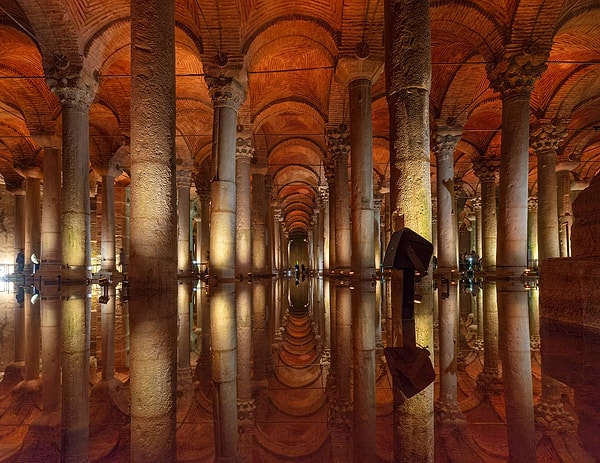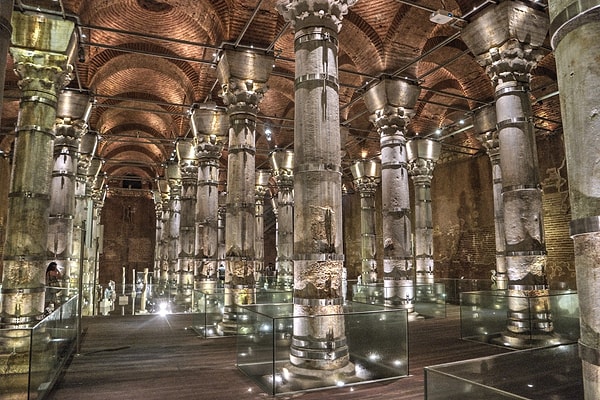Discover Istanbul’s Mysterious Cisterns: Gateways to the Ancient Underground
If you want to feel the historical texture of Istanbul at its innermost depths, the mysterious underground cisterns in the city offer a unique opportunity for discovery. These impressive structures, which have survived from the Byzantine and Ottoman periods, are of great architectural and cultural importance. Get ready to step into this underground world of history and legends by exploring the most popular cisterns of Istanbul in detail.
1. Basilica Cistern

History and Architecture
Built by Byzantine Emperor Justinian I in the 6th century, the Basilica Cistern is the largest and most impressive underground cistern in Istanbul. With an area of approximately 9,800 square meters, the cistern can store approximately 80,000 tons of water and was designed to meet the city's water needs. Located under the former Byzantine Palace, the cistern is supported by 336 marble columns and is about 9 meters high.
The columns used in the construction of the cistern were brought from different periods and structures, reflecting different architectural styles. The enchanting atmosphere of the cistern is accompanied by lighting and columns reflected on the water surface.
Legends and Mythological Elements
The first thing that comes to mind when you think of the Basilica Cistern is the two gigantic heads of Medusa in the northwest corner of the cistern. Medusa is depicted as a frightening creature in Greek mythology and her gaze turns people to stone. However, it is not known for certain why these two Medusa heads were placed upside down and sideways. Some sources suggest that they were positioned this way to ward off evil spirits, while others state that they are recycled parts of the supporting blocks.
Visit Information and Transportation

The Basilica Cistern is located in the historical peninsula of Istanbul, very close to Sultanahmet Square. It is a few minutes' walk from major tourist attractions such as the Hagia Sophia, the Topkapi Palace and the Blue Mosque.
Visiting hours are usually from 09:00 in the morning until 19:00 in the evening and entrance fees are discounted for museum cardholders. For the most convenient transportation, the Sultanahmet tram stop can be preferred. The cistern can be visited at any time of the year, but it is ideal to go early in the summer months to avoid the crowds.
Local Visitor: 200 TL
Foreign Visitor: 900 TL
What to See Nearby
After visiting the Basilica Cistern, you can visit other important buildings on the historical peninsula. Especially the Hagia Sophia Museum, the Blue Mosque, Topkapi Palace and Grand Bazaar are among the must-see places. Taking a short break in the cafes in the area will help you recharge your energy and enjoy the historical atmosphere.
2. Binbirdirek Cistern (Sarnıç-ı Binbirdirek)

History and Architecture
Although Binbirdirek Cistern is perceived as having approximately 1001 pillars like its name, it is actually a large structure supported by 224 columns. It was built by the Roman Emperor Constantine in the 4th century BC. Binbirdirek, one of the oldest large cisterns in Istanbul, was designed to meet the city's water needs during the Byzantine period and was also used during the Ottoman period.
The size of the cistern and the arrangement of the columns show the engineering success of Byzantine architecture. The columns were brought from different structures in antiquity and sometimes enriched with different types of capitals. The water collection and distribution system of the cistern reflects the advanced engineering understanding of the period.
Cultural and Historical Importance
Binbirdirek is not only a water reservoir but also an important turning point in the development of Istanbul's water systems throughout history. Actively used during the Ottoman period, the cistern played a critical role in securing the city's water needs.
Visiting Information and Transportation

Binbirdirek Cistern is located in the area between Sultanahmet and Cağaloğlu, just a few minutes walk from the Basilica Cistern. Entrance fees and visiting hours are similar to the Basilica Cistern and the museum card is valid.
During a visit to the cistern, the different cap designs of the columns and the acoustics of the structure are particularly striking. You can take a short break here and feel the cool air of the underground.
Nearby Historical Sites
Near the Binbirdirek Cistern are the Roman Hippodrome, the German Fountain and Sultanahmet Square. For visitors interested in history, it is possible to explore many historical buildings with short walks in this area.
3. Şerefiye (Theodosius) Cistern

History and Architecture
Şerefiye Cistern was built by Byzantine Emperor Theodosius II in the 5th century and covers an area of approximately 12,000 square meters. In 2015, the cistern underwent a comprehensive restoration and remained forgotten underground for many years.
The cistern is one of the early examples of Byzantine architecture and is supported by 42 marble columns. Opened to visitors after the restoration works, the place revives the historical atmosphere with modern lighting and sound effects.
Restoration and Its Importance Today
The Şerefiye Cistern, which was underground for many years and was destroyed over time, is an important structure that sheds light on the history of Istanbul's water infrastructure. With the restoration, the original architectural features of the cistern were revealed and made accessible to visitors.
Visit Information and Transportation

Şerefiye Cistern is located on the historical peninsula of Istanbul, between Eminönü and Sirkeci, very close to the Golden Horn. It is easily accessible by public transportation such as trams and buses.
Entrance fees and visiting hours should be kept up to date on cultural tourism platforms. It is generally recommended to visit in the form of guided tours.
Local Visitor: 200 TL
Foreign Visitors: 750 TL
Other Historical Sites to See in the Surroundings
There are walking paths around the cistern with views of the Istanbul Archaeology Museum, Gülhane Park and the Golden Horn. In this region, located on the historical peninsula, both nature and history offer an intertwined experience.
Keşfet ile ziyaret ettiğin tüm kategorileri tek akışta gör!

Send Comment